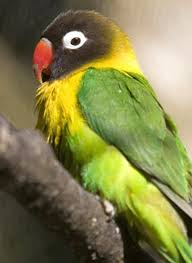Masked Lovebird

Description
The masked lovebird (Agapornis personatus), also called yellow-collared lovebird or eye ring lovebird, is a monotypic species of bird of the lovebird genus in the parrot family Psittaculidae. They are native to northeast Tanzania and have been introduced to Burundi and Kenya.
The yellow-collared lovebird is a mainly green small parrot about 14.5 cm (5.5 in) long. Its upper parts are a darker green than its lower surfaces. Its head is black, and it has a bright red beak and white eyerings. Yellow on the breast is continuous with a yellow collar and an expansion of yellow over the nape of the neck. Male and female have identical external appearance.
Scientific Name
Agapornis Personatusll
Country Of Origin
Africa
Size
Small, up to 6 inches
Life Expectancy
20 years
Noise Level
Low, although can let out a shrill shriek from time to time.
Talk / Trick Ability
Not known as a talker, but does enjoy learning tricks.
Characteristics
Not as common as the Fischer’s or peach-faced lovebird, the masked lovebird is somewhat smaller and not as aggressive as the peach faces. They enjoy chewing and constructs nests in the wild out of twigs, so provide your pet masked lovebird with plenty of toys to chew on. Masked lovebirds are also distinguished by their black heads and white eye rings.
Behavior / Health Concerns
The masked lovebird can be nippy, territorial and a prolific chewer. Masked lovedbirds can overindulge on seed, so make sure to provide plenty of fresh fruits, vegetables, whole grains and exercise. Because they are good escape artists, owners need to make sure that every opening is latched shut to prevent unwanted escapes. Masked lovebird’s age can be determined by the color of its beak. Adults have a red, orange, light gray or horn-colored beak, depending on the species. Juvenile masked lovebirds have black-marked beaks. The exception is in the black-collared lovebird, which has a gray-black beak as an adult.